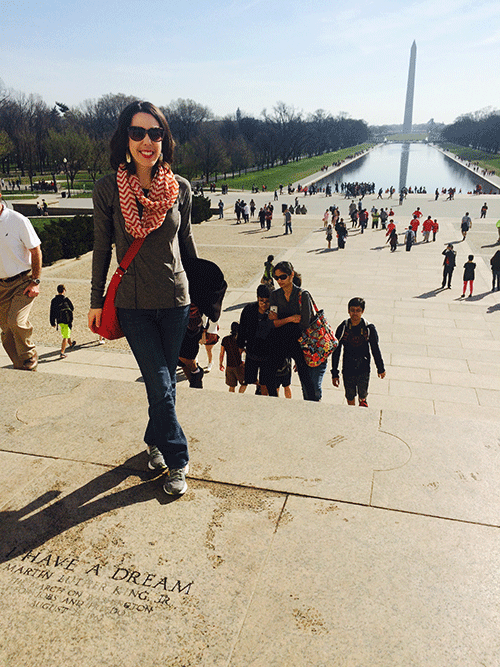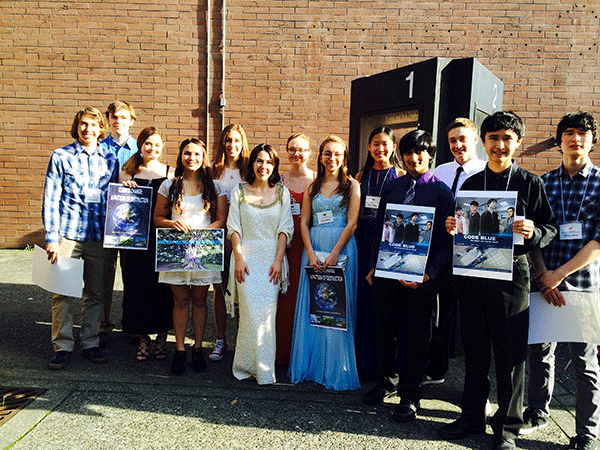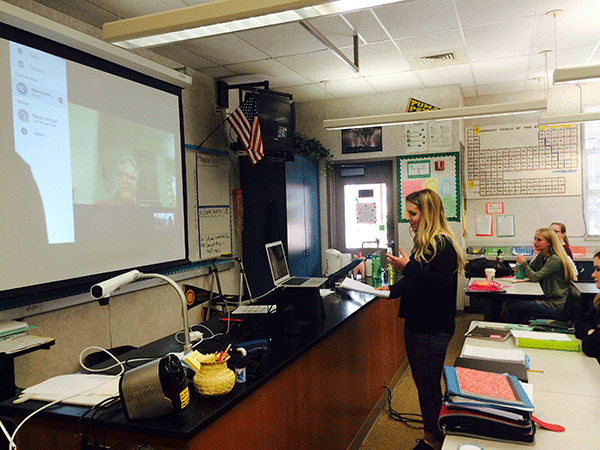The Case for Student Empowerment and Creativity in the NGSS Classroom
Author: Anna Babarinde
Published: 04.07.16
 Over spring break, I had the opportunity to travel to Washington DC. The trip included many opportunities to reflect on our national history: A visit to Ford’s Theater and the Lincoln Museum, touring the White House and the Capitol, viewing the Constitution and Declaration of Independence, and walking to almost all of the monuments. What struck me over and over again during these experiences was the high level of creativity, innovation, and audacious hope that have gone into shaping our country. What these leaders dared to think was possible led to the founding of a country, the formation of a cohesive nation, and the gradual establishment of liberty and civil rights for all.
Over spring break, I had the opportunity to travel to Washington DC. The trip included many opportunities to reflect on our national history: A visit to Ford’s Theater and the Lincoln Museum, touring the White House and the Capitol, viewing the Constitution and Declaration of Independence, and walking to almost all of the monuments. What struck me over and over again during these experiences was the high level of creativity, innovation, and audacious hope that have gone into shaping our country. What these leaders dared to think was possible led to the founding of a country, the formation of a cohesive nation, and the gradual establishment of liberty and civil rights for all.
Ever the educator, as I reflected on all I saw and learned, I pondered what experiences these people might have had that gave them the creative drive and sense of empowerment that allowed them to form and reshape a nation based on democracy. And I further wondered how we can infuse these same experiences into the classroom so that our students have the chance to develop into universal citizens and leaders who see a picture larger than their own experiences and can invoke change and enact creative solutions.
The 2012 Framework for Science Education calls for an emphasis on the nature of science. In many ways, its description of scientific process mirrors the process of shaping our country. “An education in science should show that new scientific ideas are acts of imagination, commonly created these days through collaborative efforts of groups of scientists whose critiques and arguments are fundamental to establishing which ideas are worthy of pursuing further” (NRC, 2012). Similarly, both the national NGSS and the draft CA Science Framework highlight the need for students to understand science as a human endeavor, for students to be given opportunities to engage in science that is relevant to them and the needs of the world around them, and for students to be empowered to work autonomously and collaboratively on science challenges.
As we move towards full-fledged NGSS implementation, how to empower students and inspire creativity is incredibly relevant. We are all focused on what it looks like to make lessons, units, and courses three dimensional. This requires significant shifts in curriculum, resources, and strategies. But herein lies the danger. If I develop lessons that are creative and hands-on but still rely on me to direct everything, students might learn to view science three dimensionally but not internalize science as a field that is relevant to their own lives, where they could do work that hasn’t been done and make connections that no one has seen before. If we set up science classrooms as places where teachers are doing most of the work, we could invest a significant amount of time and energy and develop amazing curriculum but still miss the opportunity offered in NGSS to empower students and inspire creativity.
Our challenge as we revise science education is not only to make classrooms truly student centered but also to provide these students with authentic experiences to tackle challenges and receive feedback. I was struck recently by the comments made by two very successful seniors in high school. These are students who have jumped through every hoop, have played the game and been accepted to excellent colleges, and who take advanced, challenging courses in science. Both of them, while appreciative of all the time and effort teachers have put into their education, said that they’re tired of investigating questions to which the answers are already known. They are quick and smart enough to know that the labs and challenges they’re given have a predictable, expected outcome. They want the chance to explore questions that haven’t been answered and come up with solutions to problems that haven’t been solved and also have relevance for their lives and the world around them. And they want the chance to communicate with others who are working on these same challenges, learn from them, and share ideas.
There are obviously roadblocks and challenges to these students’ requests and movement toward student centered classrooms. For one thing, part of science education is developing skills and understanding that will enable you to address complex challenges in science fields, and we can’t always bypass these preliminary steps. For another, setting up scenarios with this kind of student autonomy, collaboration, and creativity requires a high level of teacher content and process knowledge. As we implement NGSS, content knowledge is a challenge for many teachers, particularly those in lower grades where science has not been consistently taught over the past 15 years. Finally, particularly in upper level classes where students are most poised to explore and create independently, there is still a significant amount of content knowledge that needs to be developed in a finite amount of time, and open investigations and design challenges can be lengthy.
While these challenges are real, that doesn’t mean we can abandon the need for student empowerment and the development of creativity in the context of science. To do so would be a disadvantage for the students and our nation and world. We need more people like those who shaped our country, and as the world shrinks, environmental and health challenges become prominent, and the possibility of exploring worlds beyond our own gets nearer, we particularly need these people in STEM fields.
So what can we do? We can approach NGSS implementation and the development of particular lessons with an empowerment and creativity lens. We can also look for existing resources and supports that might help us shift science education to encourage independent thought and creative approaches to real challenges. We can try to provide opportunities for students’ voices to be heard and for them to receive feedback from and interaction with an authentic audience. These strategies might not be practical every day, but as students have more opportunities over the course of their science education they will begin to incorporate them into their own science story and picture of what science exploration can be.
 What might this look like on a practical level? While I certainly don’t have all the answers, there are several experiences my students have gotten to participate in recently that enrich their understanding of science process and content while also inspiring creativity and empowering them. One is Sonoma County’s Five Minute Film Festival. Last semester, my students worked in teams on films related to patterns in biology (the film festival theme was patterns) and submitted them as a semester project in my class. The creativity and variability of film topics and their relevance for the individual students was striking. What has been even more significant is the way students internalized the information from their films. As we tackle new topics, they refer to the material from their films and how it connects to or provides examples of the content in class. Three of the films were selected for viewing in the Film Festival showcase. Those students had the chance to dress up and walk the red carpet, see their films on the big screen at a local theater, and hear feedback from a team of celebrity judges. One of the films was about climate change, and a judge told the students that her film company is currently working on a documentary on the same topic and thanked them for sharing their information. I cannot emphasize enough the empowerment this provided for my students and the motivation it gave them to continue to use their interests and strengths creatively to support the field of science.
What might this look like on a practical level? While I certainly don’t have all the answers, there are several experiences my students have gotten to participate in recently that enrich their understanding of science process and content while also inspiring creativity and empowering them. One is Sonoma County’s Five Minute Film Festival. Last semester, my students worked in teams on films related to patterns in biology (the film festival theme was patterns) and submitted them as a semester project in my class. The creativity and variability of film topics and their relevance for the individual students was striking. What has been even more significant is the way students internalized the information from their films. As we tackle new topics, they refer to the material from their films and how it connects to or provides examples of the content in class. Three of the films were selected for viewing in the Film Festival showcase. Those students had the chance to dress up and walk the red carpet, see their films on the big screen at a local theater, and hear feedback from a team of celebrity judges. One of the films was about climate change, and a judge told the students that her film company is currently working on a documentary on the same topic and thanked them for sharing their information. I cannot emphasize enough the empowerment this provided for my students and the motivation it gave them to continue to use their interests and strengths creatively to support the field of science.
 Another stand-out experience for my students has been participating in video conferences with science experts. The world has gotten very small, and no longer do we have to rely on just the local people who happen to be available to come for a day and speak to students. Over the past two years, my classes have had the chance to speak to medical workers and experts on the Ebola virus, a cancer researcher, a conservationist focused on great cats, and marine scientists from Monterey Bay Aquarium with whom they also participated in a long distance lab. These experiences in and of themselves are significant. But what made them all the richer was the advice I received from a colleague. That advice was: prepare the class for the experience, assign students to facilitate the conversation, then get out of the way so they can run the show. Using this model means that students not only learn about real-world, relevant scientific work and the ways people are creatively using science avenues to effect change in the world, but also that they are being empowered to direct their own learning and seek out more contact with the scientific community in the future. I know that students have followed up individually with some of the people we’ve spoken to and have even gone to visit them. I am encouraged to think how this might change my students’ trajectories in life and their interest in scientific work.
Another stand-out experience for my students has been participating in video conferences with science experts. The world has gotten very small, and no longer do we have to rely on just the local people who happen to be available to come for a day and speak to students. Over the past two years, my classes have had the chance to speak to medical workers and experts on the Ebola virus, a cancer researcher, a conservationist focused on great cats, and marine scientists from Monterey Bay Aquarium with whom they also participated in a long distance lab. These experiences in and of themselves are significant. But what made them all the richer was the advice I received from a colleague. That advice was: prepare the class for the experience, assign students to facilitate the conversation, then get out of the way so they can run the show. Using this model means that students not only learn about real-world, relevant scientific work and the ways people are creatively using science avenues to effect change in the world, but also that they are being empowered to direct their own learning and seek out more contact with the scientific community in the future. I know that students have followed up individually with some of the people we’ve spoken to and have even gone to visit them. I am encouraged to think how this might change my students’ trajectories in life and their interest in scientific work.
There are without question a lot of moving parts in this transition to NGSS, but we need to actively look for and build in opportunities like these whenever possible. I encourage you to seek them out and brainstorm with others about what this might look like in your context. If my examples are helpful, I’m happy to give you more details and resources, but please don’t be limited to these. There are many different opportunities out there, and even more that haven’t yet been thought of or tried. The value of these is high, and the possibilities and the potential abound. We are quite literally living in the United States of America as it exists today because leaders were invested in and empowered. Their ability to collaborate and think creatively was fostered. How much potential might our future hold if we continue to seek out opportunities to do this in the NGSS classroom?
Blog: Exploring NGSS

